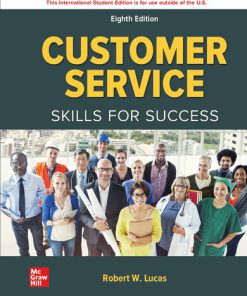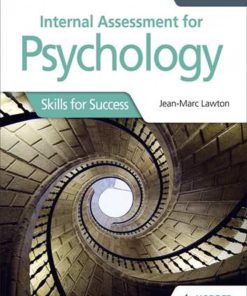Skills for Success Personal Development and Employability 4th Edition by Stella Cottrell ISBN 9781352011593 135201159X
$50.00 Original price was: $50.00.$25.00Current price is: $25.00.
Skills for Success Personal Development and Employability 4th Edition by Stella Cottrell – Ebook PDF Instant Download/Delivery: 9781352011593 ,135201159X
Full download Skills for Success Personal Development and Employability 4th Edition after payment

Product details:
ISBN 10: 135201159X
ISBN 13: 9781352011593
Author: Stella Cottrell
Skills for Success Personal Development and Employability 4th Edition Table of contents:
Part 1 Self-management
1. Taking charge of your future
Getting started with Personal Development Planning (PDP)
‘PDP’: What is it?
PDP as a process
Personal development involves …
Why PDP matters for students
PDP: what students say
PDP: what graduates say
PDP in employment
Managing the challenges
Identify personal benefits of PDP
Do I need PDP? Self-evaluation
What are my PDP priorities?
Priorities whilst a student
Take a rounded approach to PDP
Make the commitment to your PDP
Take and make opportunities
Review: Taking charge of your future
2. The vision: what does success mean to you?
Defining success
Values
Which values?
Testing our values
Inspiration
Clarifying the vision
The long-term vision
Achieve the vision: set interim goals
Personal investment: benefits and costs of achieving goals
Sustaining the motivation to achieve
Ingredients of success: learning from CEOs
Ingredients of success – for goals
Attributes associated with success
Attributes needed to achieve your goal
Congruence and integrity
Does it all add up?
Review: The vision
3. Know yourself
Develop your own narrative
Themes in your tale
Yourself as Hero
Identify your personal caricature
Choices
Your top forty and significant seven
Your learning history
What helps you to learn?
Responding to setbacks
Drawing on your expertise
Personal expertise metaphor: examples
Applying your expertise
Review: Know yourself
4. Improving your personal performance
Achieving more
Personal performance and ‘SHAPES’
Changing SHAPES
Find your SHAPES for academic study
Rate yourself: habits and attitudes
Rate yourself: preferences and experience
Rate yourself: strategies
Map your SHAPES profile
Use your SHAPES profile
Performance Factors 1: Structure
Performance Factors 2: External direction
Performance Factors 3: Social
Performance Factors 4: Sensory stimulus
Performance Factors 5: Global or serial
Performance Factors 6: Pressure
Performance Factors 7: Approach
Performance Factors 8: Sensory mode
Performance Factors 9: Well-being
Personal Performance Profile
Identify significant features
Personal Performance Formula (PPF)
Name it! Test it!
Test your Personal Performance Formula (PPF): Task 1
Test your Personal Performance Formula (PPF): Task 2
Test what works for you
Apply your PPF
Review: Improving your personal performance
5. Successful self-management
Aspects of self-management
Take the initiative
Taking personal responsibility
Getting on with it – or not
Eight levels: motivators and inhibitors
Speech indicators of ‘level’
Managing performance at the right level
Self-belief, hope and optimism
Self-permission
Being positive and ‘solution-focused’
Emotional intelligence
Evaluate your emotional self-management
Emotional self-management
Unexpressed emotions
Managing personal distress
The ABC(D) model for dealing with distress
Managing change, confusion, uncertainty
Uncertainty: wanting ‘right answers’
Holding uncertainty
Coping with change
Understand your time character
Manage time more effectively
Improve your time management
Review: Successful self-management
Part 2 People and task management skills
6. People skills
How good are your people skills now?
People skills
Developing rapport
Skilful, active listening
Developing mutual trust
Finding allies and forming networks
Constructive criticism
Being assertive
Using assertiveness techniques
Dealing with difficult people
Managing difficult situations
Negotiation skills and persuasiveness
Decide your negotiating position
Conduct a persuasive negotiation
Change recurring situations
Monitor your progress
Review: People skills
7. Teamwork
Teamwork as a student
Being part of a great team
Creating a great team
Team functions and Belbin team types
Helping the team to work well
How do I behave in teams/groups?
Understand team dynamics
Involve and include the whole team
Managing team conflict
Confronting team members
What I can contribute
Teamwork when applying for jobs
Review: Teamwork
8. Develop your leadership capacity
Why does this matter for me?
Different kinds of leader
What is leadership? Two models
Leadership styles
Right style for the context?
Key leadership orientations
What do you want in a leader?
Cultural differences in leadership
Seeing yourself as a ‘leader’
Your leadership style preferences
Preparing for leadership
Step up to responsibility
Being an effective leader
Get the basics right
Review: Develop your leadership capacity
9. Managing tasks and projects
Rate your task-management capability
Make the task manageable
OPAL strategy for task management
OPAL strategy: planning and action
OPAL strategy: learning from the task
Task-management techniques
Conduct SWOT and TOWS analyses
Use SMART-F target setting
Planning project time: action plans
Schedules and project diary
Being a ‘good self-starter’
… and keeping going
Be a ‘completer-finisher’
Characteristics of projects
Successful project management
Evaluate your task/project performance
Communicating about tasks/projects
Review: Managing tasks and projects
Part 3 Extending your thinking
10. Thinking creatively and productively
Being open to enhanced brain power
Evaluate your creative thinking skills
Interpret your creative thinking score
A dozen really useful things to know about your brain
Stimulate your brain
Help your brain find patterns
Let your brain be playful
Help your brain find answers for you
Give it food, water, exercise
Put your brain in the right mood
Calm the mind and clear mental clutter
Opening up to creativity
Take ‘light touch’ approaches
Synthesis – the heart of creativity
Form creative habits
Creating thought ‘networks’
Network: creative thinking
Lateral thinking
Working with raw material
Creativity and risk-taking
Boost your creativity
Review: Thinking creatively and productively
11. Practical problem-solving
Potential barriers to problem-solving
Getting started: use your resources
Defining the problem
Write a problem statement
Working towards a problem solution
Draw on familiar approaches
Structure the problem
Draw on analogous (similar) problems
The ‘multiple solution’ approach
Evaluating multiple solutions
Deciding on a solution using criteria
Problem-solving using action sets
Review: Practical problem-solving
12. The art of reflection
Why engage in reflection?
What is ‘reflection’?
The relevance of reflection to me
Reflective practice
Nine steps for improving self-reflection
Question-based reflection
Open reflection: generating ideas
Open reflection: multiple routes
Open reflection: free-writing
Synthetic reflection
Developmental reflection
Reflecting on transferable skills
Reflecting on academic development
Reflecting on professional development
Evaluative reflection: critical events
Using feedback
Models of reflection 1
Models of reflection 2
Models of reflection 3
The Core Model for Reflection
Devise your own model for reflection
Presenting your reflection to others
Selective reflective portfolios
Reflective essays
Personal statement
Position papers
Review: The art of reflection
Part 4 Employability: enhancing your career prospects
13. What do employers really want?
What is ‘employability’?
Put yourself in employers’ shoes
What employers want: large employers and SMEs
What employers want: work-readiness
What employers want: specialists or generalists?
What employers want: how does this change?
What employers value
Translating academic skills for the workplace
Writing skills for the workplace
Communication skills for the workplace
Oral communication skills for the workplace
People skills for the workplace
Task-management skills for the workplace
Self-management skills for the workplace
Employer case studies: skill sets in the workplace
Being your own employer: pros and cons
Being your own employer: eight essentials
Review: What do employers really want
14. Getting the job you want
What students and graduates say
Career planning: Aspire, Act, Apply, Achieve
Career planning journey: Aspire, Act, Apply, Achieve
Models of career development
Responsive career planning
Which careers and jobs would suit me?
Gaining experience of work
Work placements and internships: the benefits
Effective use of your experience of work
What do you want from a ‘graduate’ job?
Activity: What do I want from the job?
Choosing a job
What do you want from an employer?
Plan ahead
Finding a job
Making a job application
Covering letter
Write a personal statement
Curriculum vitae (CV)
CV: example
Using your CV
Prepare for assessment centres
Referring to disabilities
Preparing for the interview
In the interview
Questions to prepare
Other typical questions
Closing the interview
After the interview
Review: Getting the job you want
15. Building a professional identity: reputation, personal profile and records
Cultivate your professional identity
Stand out – for the right reasons
Shape your online profile
Keep yourself organised
Portfolios; Progress files; HEAR
Contents list: portfolios/personal records
Records to support applications
Current skills and personal qualities
Records of competences
Recording your competence
Records of reflection
Reflective material
Review: Building a professional identity
Appendices 1. Applications for success
Appendices 2. Useful websites
ResourcesEvaluate whether your PDP goalsare SMART-F
Personal Action Plan for PDP
Evaluate your targets as SMART-F
Action Plan: Version 1
Action Plan: Version 2
References and Bibliography
Index
People also search for Skills for Success Personal Development and Employability 4th Edition:
q skills for success listening and speaking
q skills for success 1
leadership personal development and career success pdf
skills for success madera ca
skills for successful mentoring
Tags: Stella Cottrell, Success, Personal Development, Employability
You may also like…
Business & Economics - Sales & Marketing
Customer Service Skills for Success 8th Edition Robert W. Lucas
History & Research
Education Studies & Teaching - Studying & Test Preparation
Relationships & Lifestyle - Personal Growth & Inspiration
Critical Thinking Skills Effective Analysis Argument and Reflection 4th Edition Stella Cottrell
Uncategorized
Critical Thinking Skills Effective Analysis Argument and Reflection 4th Edition Stella Cottrell
Politics & Philosophy - General & Miscellaneous Philosophy
Critical Thinking Skills – Developing Efctive Analysis and Argument 3rd Edition Stella Cottrell











